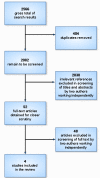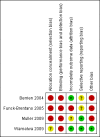Interventions to improve adherence to antiretroviral therapy in children with HIV infection
- PMID: 22161452
- PMCID: PMC6599820
- DOI: 10.1002/14651858.CD009513
Interventions to improve adherence to antiretroviral therapy in children with HIV infection
Abstract
Background: Achieving and maintaining high levels of medication adherence are required to achieve the full benefits of antiretroviral therapy (ART), yet suboptimal adherence among children is common in both developed and developing countries.
Objectives: To conduct a systematic review of the literature of evaluations of interventions for improving paediatric ART adherence.
Search methods: We created a comprehensive search strategy in order to identify all studies relevant to this topic. In July 2010, we searched the following electronic databases: EMBASE, MEDLINE, PsycINFO, Cochrane Central Register of Controlled Trials (CENTRAL), CINAHL, LILACS, Web of Science, Web of Social Science, NLM Gateway (supplemented by a manual search of the most recent abstracts not included in the Gateway database). We searched abstracts from the International AIDS Conference from 2002 to 2010, the International AIDS Society Conference on Pathogenesis, Treatment and Prevention from 2003 to 2009, and from the Conference on Retroviruses and Opportunistic Infections from 1997 to 2010. We used search strategies determined by the Cochrane Review Group on HIV/AIDS. We also contacted researchers who work in this field and checked reference lists of related systematic reviews and of all included studies.
Selection criteria: Randomised and non-randomised controlled trials of interventions to improve adherence to ART among children and adolescents (age ≤18 years) were included. Studies had to report adherence to ART as an outcome.
Data collection and analysis: After one author performed an initial screening to exclude citations that did not meet the inclusion criteria, two authors did a second screening of those citations that likely met the criteria. For all articles that passed the second screening, full articles were pulled in order to make a final determination. Two authors then extracted data and graded methodological quality independently. Differences were resolved through discussion.
Main results: Four studies met the inclusion criteria. No single intervention was evaluated by more than one trial. Two studies were conducted in low-income countries. Two studies were randomised controlled trials (RCT), and two were non-randomised trials. An RCT of a home-based nursing programme showed a positive effect of the intervention on knowledge and medication refills (p=.002), but no effect on CD4 count and viral load. A second RCT of caregiver medication diaries showed that the intervention group had fewer participants reporting no missed doses compared to the control group (85% vs. 92%, respectively), although this difference was not statistically significant (p=.08). The intervention had no effect on CD4 percentage or viral load. A non-randomised trial of peer support group therapy for adolescents demonstrated no change in self-reported adherence, yet the percentage of participants with suppressed viral load increased from 30% to 80% (p=.06). The second non-randomised trial found that the percentage of children achieving >80% adherence was no different between children on a lopinavir-ritonavir (LPV/r) regimen compared to children on a non-nucleoside reverse transcriptase regimen (p=.781). However, the proportion of children achieving virological suppression was significantly greater for children on the LPV/r regimen than for children on the NNRTI-containing regimen (p=.002).
Authors' conclusions: A home-based nursing intervention has the potential to improve ART adherence, but more evidence is needed. Medication diaries do not appear to have an effect on adherence or disease outcomes. Two interventions, an LPV/r-containing regimen and peer support therapy for adolescents, did not demonstrate improvements in adherence, yet demonstrated greater viral load suppression compared to control groups, suggesting a different mechanism for improved health outcomes. Well-designed evaluations of interventions to improve paediatric adherence to ART are needed.
Conflict of interest statement
None to declare.
Figures
References
References to studies included in this review
-
- Berrien VM, Salazar JC, Reynolds E, McKay K. Adherence to antiretroviral therapy in HIV‐infected pediatric patients improves with home‐based intensive nursing intervention. AIDS Patient Care and STDs June 2004;18(6):355‐63. - PubMed
-
- Funck‐Brentano I, Dalban C, Veber F, Quartier P, Hefez S, Costagliola D, Blanche S. Evaluation of a peer support group therapy for HIV‐infected adolescents. AIDS Sept 2005;19(14):1501‐8. - PubMed
-
- Muller AD, Myer L, Jaspan H. Virological suppression achieved with suboptimal adherence levels among South African children receiving boosted protease inhibitor‐based antiretroviral therapy. Clinical Infectious Diseases Jan 2009;48(1):e3‐5. - PubMed
-
- Wamalwa DC, Farquhar C, Obimbo EM, Selig S, Mbori‐Ngacha DA, Richardson BA, Overbaugh J, Egondi T, Inwani I, John‐Stewart G. Medication diaries do not improve outcomes with highly active antiretroviral therapy in Kenyan children: a randomized clinical trial. Journal of the International AIDS Society June 2009;12(1):8. - PMC - PubMed
References to studies excluded from this review
-
- Baldassari S, Bernardi S, Montecchi F, Cancrini C, Bufacchi C, Rossi P, Gasperini I, Castelli‐G G. Multidisciplinary approach to the disclosure of diagnosis and treatment compliance in children with HIV. 14th International AIDS Conference, Barcelona, Spain. 2002 July 7‐12:abstract no.: MoPeE3849.
-
- Byakika‐Tusiime J, Crane J, Oyugi JH, Ragland K, Kawuma A, Musoke P, Bangsberg DR. Longitudinal antiretroviral adherence in HIV+ Ugandan parents and their children initiating HAART in the MTCT‐Plus family treatment model: role of depression in declining adherence over time. AIDS & Behavior 2009;13(Suppl 1):82‐91. - PubMed
-
- Calles NR, Ferris MG, Raneri LG, Schwarzwald H, Simon C, Kline MW. KIDS‐2‐KIDS: medication dedication. 13th International AIDS Conference, Durban, South Africa. 2000 July 9‐14:abstract no.: ThPeB5074.
References to ongoing studies
-
- New MJ, Earp MJ, Dominguez KL, et al. Pediatric IMPACT: An intervention to promote adherence to antiretroviral medications in pediatric HIV. US National HIV Prevention Conference, June 12‐15, 2005, Atlanta, USA.
Additional references
-
- Bangsberg DR, Perry S, Charlebois ED, Clark RA, Roberston M, Zolopa AR, Moss A. Non‐adherence to highly active antiretroviral therapy predicts progression to AIDS. AIDS 2001;15(9):1181‐3. - PubMed
-
- Eley B, Nuttall J, Davies MA, Smith L, Cowburn C, Buys H, Hussey G. Initial experience of a public sector antiretroviral treatment programme for HIV‐infected children and their infected parents. South African Medical Journal 2004;94(8):643‐6. - PubMed
-
- Ford N, Nachega JB, Engel ME, Mills EJ. Directly observed antiretroviral therapy: A systematic review and meta‐analysis of randomised clinical trials. Lancet 2009;374:2064‐71. - PubMed
-
- Harrigan PR, Hogg RS, Dong WW, Yip B, Wynhoven B, Woodward J, Brumme CJ, Brumme ZL, Mo T, Alexander CS, Montaner JS. Predictors of HIV drug‐resistance mutations in a large antiretroviral‐naive cohort initiating triple antiretroviral therapy. Journal of Infectious Diseases 2005;191(3):339‐47. - PubMed
Publication types
MeSH terms
Substances
LinkOut - more resources
Full Text Sources
Medical
Research Materials
Miscellaneous




